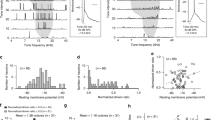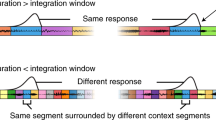Abstract
SINGLE unit studies of the auditory nerve, such as that of Tasaki1, have shown that the neurones innervating the cochlea are in general sharply tuned, each to its own characteristic frequency (CF). In response to a sharp click a unit of mid or low CF tends to fire repetitively and at preferred times, as if stimulated by a poorly damped resonator very sharply tuned to its CF2. In contrast, the travelling wave generated as the mechanical response to a pure tone, as measured by von Békésy3, has a relatively flat amplitude envelope and the impulse response for the basilar membrane computed on the basis of von Bekesy's data indicates that the system is highly damped4. We propose a fresh approach, not based on the principle of mechanical resonance5–7.
This is a preview of subscription content, access via your institution
Access options
Subscribe to this journal
Receive 51 print issues and online access
$199.00 per year
only $3.90 per issue
Buy this article
- Purchase on Springer Link
- Instant access to full article PDF
Prices may be subject to local taxes which are calculated during checkout
Similar content being viewed by others
References
Tasaki, I., J. Neurophysiol., 17, 97 (1954).
Kiang, N. Y.-S., Discharge Patterns of Single Fibers in the Cat's Auditory Nerve, MIT Research Monograph No. 35 (MIT Press, Cambridge, Massachusetts, 1965).
von Békésy, G., Experiments in Hearing (McGraw-Hill, New York, 1960).
Flanagan, J. L., J. Acoust. Soc. Amer., 34, 1370 (1962).
Weiss, T. F., Kybernetik, 3, 153 (1966).
Huxley, A. F., Nature, 221, 935 (1969).
Lynn, P. A., and Sayers, B. McA., J. Acoust. Soc. Amer., 47, Part 2, 525 (1970).
Flanagan, J. L., and Bird, C. M., J. Acoust. Soc. Amer., 34, 114 (1962).
Tasaki, I., Davis, H., and Legouix, J.-P., J. Acoust. Soc. Amer., 24, 502 (1952).
Nordmark, J. O., Glattke, T. J., and Schubert, E. D., J. Acoust. Soc. Amer., 46, Part 2, 1587 (1969).
Spoendlin, H., The Organization of the Cochlear Receptor (S. Karger, Basel, Switzerland, 1966).
Spoendlin, H., Acta Otolaryngol., 67, 239 (1969).
Johnstone, B. M., and Boyle, A. J. F., Science, 158, 389 (1967).
Møller, A. R., Acta Physiol. Scand., 78, 299 (1970).
Katsuki, Y., Suga, N., and Kanno, Y., J. Acoust. Soc. Amer., 34, 1396 (1962).
Rupert, A., Moushegian, G., and Galambos, R., J. Neurophysiol., 26, 449 (1963).
Frishkopf, L. S., J. Acoust. Soc. Amer., 36, 1016 (1964).
Nieder, P., and Nieder, I., Nature, 227, 184 (1970).
Nieder, P., and Nieder, I., Brain Res., 21, 135 (1970).
Nieder, P., and Nieder, I., Exp. Neurol., 28, 179 (1970).
Dewson, J. H. III, J. Neurophysiol., 31, 122 (1968).
Author information
Authors and Affiliations
Rights and permissions
About this article
Cite this article
NIEDER, P. Addressed Exponential Delay Line Theory of Cochlear Organization. Nature 230, 255–257 (1971). https://doi.org/10.1038/230255a0
Received:
Revised:
Issue Date:
DOI: https://doi.org/10.1038/230255a0
This article is cited by
-
Spatial cross-correlation
Biological Cybernetics (1983)
-
Filter function of the guinea pig cochlea after degeneration of outer hair cells
Archives of Oto-Rhino-Laryngology (1977)
-
Supporting Evidence from Single Unit Experiments for the Cochlea as an Addressed Delay Line
Nature New Biology (1972)
-
Degeneration behaviour of the cochlear nerve
Archiv f�r Klinische und Experimentelle Ohren- Nasen- und Kehlkopfheilkunde (1971)
Comments
By submitting a comment you agree to abide by our Terms and Community Guidelines. If you find something abusive or that does not comply with our terms or guidelines please flag it as inappropriate.



